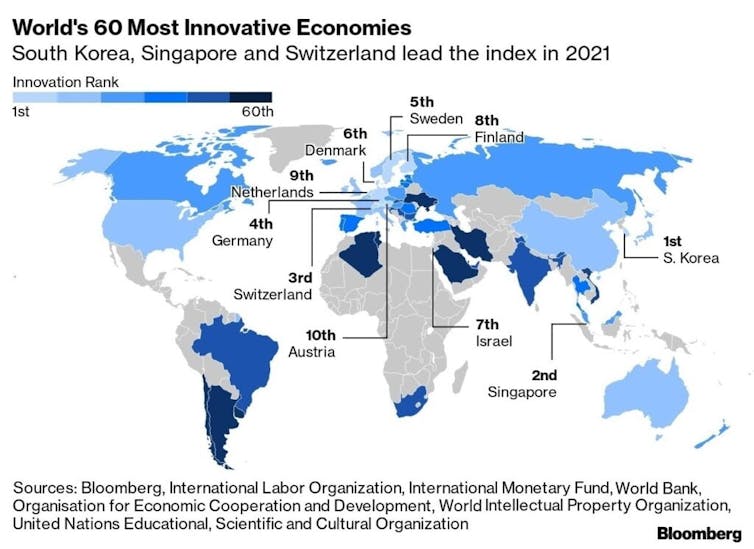Canada Has Everything It Needs to Innovate but Fails to Invest Enough In R&D

Since 2015, Canada has not been able to join the top 20 most innovative countries. Shutterstock
Innovate or perish. If companies want to survive, taking this approach is not really a matter of choice. Innovation is crucial if they are to take on the rising market competition that forces companies to stand out from the crowd. Canada needs to invest more in order to stimulate innovation.
As a professor of finance, I have an interest in corporate finance, particularly in capital structure, dividend policy, and governance. I recently undertook a major research project studying business innovation around the world. The results of an initial study on the impact of national culture on innovation have now been published in the Journal of Corporate Finance.
Canada can do better
At the top of the latest ranking in the innovation index published by Bloomberg last February is South Korea, followed by Singapore; the rest of the top ten is made up of eight European countries, including three Scandinavian countries. Canada ranks 21st in the world, one spot higher than in 2020. While it was ranked 121st globally in 2015, it still has not been able to join the world’s top 20 most innovative countries.
It should be noted, however, that some of the components included in Bloomberg’s general innovation index are inputs in the innovation process, such as spending on research and development (R&D) or postsecondary education, which is Canada’s weak spot (37th in the world).
Oddly enough, and despite its average ranking for inputs, Canada is in the top five in the world for patent generation, which is a measure of innovation output.
What explains this disparity in Canada’s ranking, between innovation inputs and outputs?
Ingredients of innovation
Innovation is not a matter solely of financial resources. Indeed, as a G7 country, Canada is not the only country whose GDP rank is significantly lower than its ranking for innovation.
The United States, the richest country in the world, is no longer in the top ten in Bloomberg’s innovation index. It is outpaced by countries with much lower GDPs, such as Finland (8th most innovative country, ranked 43rd by GDP) or Austria (10th in innovation, 26th in GDP).

Institutional factors can help or hinder the innovation process and several scientific studies have made an attempt to identify them.
An informal institutional factor linked to innovation is culture. Gerard Hofstede, a Dutch psychologist, pioneered the study of the culture of societies. He identified six cultural attributes: power distance, long-term orientation, indulgence, uncertainty avoidance, individualism, and what he called “masculine” values, which actually reflect the level of competitiveness among individuals.
Importance of culture
Our study, published in February 2021, examines the impact of these cultural dimensions on innovation. The results are very revealing:
-
Power distance, which measures the degree to which individuals in an organization accept the unequal distribution of power, has a negative effect on innovation. In societies where this index is high, individuals have limited access to information, which hinders innovation. In contrast, in societies with a low power-distance index, such as Scandinavian countries, individuals have more freedom and more incentives to innovate.
-
Indulgence indicates the degree to which societies give people the freedom to satisfy their desires. People in societies with high indulgence scores are generally optimistic, encourage discussion and dialogue in meetings and decision-making processes, and prioritize feedback, coaching and mentoring. These characteristics are assets for innovation.
-
Firms operating in long-term oriented societies are more likely to innovate. In these societies, individuals tend to exhibit more perseverance and persistence. They accept that results take time to achieve and tend to build long-term relationships with their employers.
-
Uncertainty avoidance captures a society’s tolerance for ambiguity. Societies where this index is high view anything different as dangerous and protect themselves by enacting strict laws and rules. These societies are less innovative because they are more resistant to change and new ideas.
-
The level of individualism indicates the degree to which individuals are dissociated and disconnected from groups. In individualistic societies, as opposed to collectivist societies such as communist countries, the values of individual freedom and initiative are encouraged and rewarded. Innovation is encouraged in these societies, which provide a dynamic and stimulating environment for creativity.
-
Hofstede’s “masculine” values, such as assertiveness and competitiveness, do not foster innovation. In societies that value modesty and altruism, the emphasis is on conflict resolution, trust and emotional support, and there is a higher probability that firms will innovate.
Fertile ground
If we consider the six dimensions of culture, Canada scores high on individualism and indulgence, has a moderately “masculine” score, and scores rather low on uncertainty avoidance, power distance, and long-term orientation.
This means that, with the exception of long-term orientation, the other five attributes of Canadian culture are likely to foster innovation. This could explain, at least in part, why Canada is doing well in patent production despite a rather modest score when it comes to the ingredients of innovation.
Canada would therefore provide fertile ground for innovation, where the ingredients need only be sown in order to reap the benefits. The general culture in the country is largely conducive to innovation. Because culture is a set of enduring values, beliefs and preferences that are very slow to change, Canada’s cultural advantage when it comes to innovation is here for good. What is therefore needed is to capitalize on this asset by investing heavily in R&D, both in manufacturing and high technology and in postsecondary education.